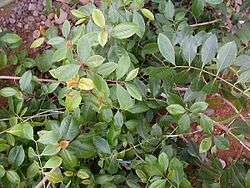Cathine
 | |
 | |
| Clinical data | |
|---|---|
| Routes of administration | Oral |
| ATC code | A08AA07 (WHO) |
| Legal status | |
| Legal status |
|
| Pharmacokinetic data | |
| Biological half-life | 1.8-8.6 h[1] |
| Identifiers | |
| |
| CAS Number |
492-39-7 |
| PubChem (CID) | 441457 |
| DrugBank |
DB01486 |
| ChemSpider |
390189 |
| UNII |
E1L4ZW2F8O |
| ChEMBL |
CHEMBL1412041 |
| ECHA InfoCard | 100.007.050 |
| Chemical and physical data | |
| Formula | C9H13NO |
| Molar mass | 151.206 g/mol |
| 3D model (Jmol) | Interactive image |
| |
| |
| | |
Cathine, also known as d-norpseudoephedrine and (+)-norpseudoephedrine, is a psychoactive drug of the phenethylamine and amphetamine chemical classes which acts as a stimulant. Along with cathinone, it is found naturally in Catha edulis (khat), and contributes to its overall effects.[2] It has approximately 10-14% the potency of amphetamine.[2]
Pharmacology
Like amphetamines, cathinone, and ephedrine, cathine acts as a norepinephrine releasing agent (NRA).[2] It also acts as a dopamine releasing agent (DRA) to a lesser extent.[2]
Chemistry
Cathine is one of the enantiomers of phenylpropanolamine (PPA).
Regulation
The World Anti-Doping Agency's list of prohibited substances (used for the Olympic Games among other athletic events) bars cathine in concentrations of over 5 micrograms per milliliter in urine. Cathine is a Schedule III drug under the Convention on Psychotropic Substances.[3] In the United States, it is classified as a Schedule IV controlled substance.
In Australia, Cathine is officially a schedule 4 drug but is not yet available or approved for any use.

In Hong Kong, cathine is regulated under Schedule 1 of Hong Kong's Chapter 134 Dangerous Drugs Ordinance. Unlawful possession is punishable by severe fines and imprisonment.
See also
- L-Norpseudoephedrine, an enantiomer
- Phenylpropanolamine
- Catha edulis ("Khat")
- Cathinone
- Methcathinone
- Ephedra sinica ("Ephedra")
- Ephedrine
- Pseudoephedrine
- Phenethylamine
- Amphetamine
- Methamphetamine
References
- ↑ Toennes SW, Harder S, Schramm M, Niess C, Kauert GF (2003). "Pharmacokinetics of cathinone, cathine and norephedrine after the chewing of khat leaves". Br J Clin Pharmacol. 56 (1): 125–130. doi:10.1046/j.1365-2125.2003.01834.x. PMC 1884326
 . PMID 12848785.
. PMID 12848785. - 1 2 3 4 Hoffman, R; Al'Absi, M (December 2010). "Khat use and neurobehavioral functions: suggestions for future studies." (PDF). Journal of Ethnopharmacology. 132 (3): 554–63. doi:10.1016/j.jep.2010.05.033. PMC 2976806
 . PMID 20553832.
. PMID 20553832. - ↑ "List of psychotropic substances under international control" (PDF). International Narcotics Control Board. Archived from the original (PDF) on 2012-08-31.
Decongestants and other nasal preparations (R01) | |||||||||||||||
|---|---|---|---|---|---|---|---|---|---|---|---|---|---|---|---|
| Topical |
| ||||||||||||||
| Systemic use: Sympathomimetics | |||||||||||||||
| α1 |
| ||||||
|---|---|---|---|---|---|---|---|
| α2 |
| ||||||
| β |
| ||||||
| |||||||
| Phenethylamines |
|
|---|---|
| Amphetamines |
|
| Phentermines |
|
| Cathinones |
|
| Phenylisobutylamines | |
| Phenylalkylpyrrolidines | |
| Catecholamines (and close relatives) |
|
| Miscellaneous |
|